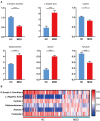Non-targeted Metabolomics Profiling of Plasma Samples From Patients With Major Depressive Disorder
- PMID: 35264984
- PMCID: PMC8899025
- DOI: 10.3389/fpsyt.2021.810302
Non-targeted Metabolomics Profiling of Plasma Samples From Patients With Major Depressive Disorder
Abstract
Background: Major depressive disorder (MDD) is a neuropsychiatric disorder caused by multiple factors. Although there are clear guidelines for the diagnosis of MDD, the direct and objective diagnostic methods remain inadequate thus far.
Methods: This study aims to discover peripheral biomarkers in patients with MDD and promote the diagnosis of MDD. Plasma samples of healthy controls (HCs, n = 52) and patients with MDD (n = 38) were collected, and then, metabolism analysis was performed using ultrahigh-performance liquid chromatography-tandem mass spectrometry (LC-MS/MS). Heatmap analysis was performed to identify the different metabolites. Meanwhile, receiver operating characteristic (ROC) curves of these differential metabolites were generated.
Results: Six differential metabolites were found by LC-MS/MS analysis. Three of these were increased, including L-aspartic acid (Asp), diethanolamine, and alanine. Three were decreased, including O-acetyl-L-carnitine (LAC), cystine, and fumarate. In addition, LAC, Asp, fumarate, and alanine showed large areas under the curve (AUCs) by ROC analysis.
Conclusion: The study explored differences in peripheral blood between depressed patients and HCs. These results indicated that differential metabolites with large AUCs may have the potential to be promising biomarkers for the diagnosis of MDD.
Keywords: LC-MS/MS; biomarkers; diagnosis; major depressive disorder; non-targeted metabolomics; plasma; receiver operating characteristic curve.
Copyright © 2022 Wu, Yu, Tian, Wang, He, Lan, Li, Bai, Chen, Chen, Ji, Zhang, Jin, Song, Cheng and Xie.
Conflict of interest statement
The authors declare that the research was conducted in the absence of any commercial or financial relationships that could be construed as a potential conflict of interest.
Figures




Similar articles
-
L-Carnitine and Acetyl-L-Carnitine: Potential Novel Biomarkers for Major Depressive Disorder.Front Psychiatry. 2021 Sep 30;12:671151. doi: 10.3389/fpsyt.2021.671151. eCollection 2021. Front Psychiatry. 2021. PMID: 34658942 Free PMC article.
-
The Utility of Amino Acid Metabolites in the Diagnosis of Major Depressive Disorder and Correlations with Depression Severity.Int J Mol Sci. 2023 Jan 23;24(3):2231. doi: 10.3390/ijms24032231. Int J Mol Sci. 2023. PMID: 36768551 Free PMC article.
-
Discovery and validation of plasma biomarkers for major depressive disorder classification based on liquid chromatography-mass spectrometry.J Proteome Res. 2015 May 1;14(5):2322-30. doi: 10.1021/acs.jproteome.5b00144. Epub 2015 Mar 26. J Proteome Res. 2015. PMID: 25784130
-
Divergent Urinary Metabolic Phenotypes between Major Depressive Disorder and Bipolar Disorder Identified by a Combined GC-MS and NMR Spectroscopic Metabonomic Approach.J Proteome Res. 2015 Aug 7;14(8):3382-9. doi: 10.1021/acs.jproteome.5b00434. Epub 2015 Jul 20. J Proteome Res. 2015. PMID: 26168936
-
The contribution of polyamine pathway to determinations of diagnosis for treatment-resistant depression: A metabolomic analysis.Prog Neuropsychopharmacol Biol Psychiatry. 2024 Jan 10;128:110849. doi: 10.1016/j.pnpbp.2023.110849. Epub 2023 Sep 1. Prog Neuropsychopharmacol Biol Psychiatry. 2024. PMID: 37659714 Review.
Cited by
-
Plasma Lyso-PE 22:6 and Lyso-PE 20:4 are associated with development of mild to moderate depression revealed by metabolomics: a pilot study.BMC Psychiatry. 2025 Jul 1;25(1):597. doi: 10.1186/s12888-025-07051-4. BMC Psychiatry. 2025. PMID: 40597055 Free PMC article.
-
Oral D-ribose causes depressive-like behavior by altering glycerophospholipid metabolism via the gut-brain axis.Commun Biol. 2024 Jan 9;7(1):69. doi: 10.1038/s42003-023-05759-1. Commun Biol. 2024. PMID: 38195757 Free PMC article.
-
Caffeine and Sports Performance: The Conflict between Caffeine Intake to Enhance Performance and Avoiding Caffeine to Ensure Sleep Quality.Sports Med. 2025 Jul;55(7):1579-1592. doi: 10.1007/s40279-025-02245-y. Epub 2025 Jun 27. Sports Med. 2025. PMID: 40579619 Free PMC article. Review.
-
Recent Progress in Mass Spectrometry-Based Metabolomics in Major Depressive Disorder Research.Molecules. 2023 Nov 4;28(21):7430. doi: 10.3390/molecules28217430. Molecules. 2023. PMID: 37959849 Free PMC article. Review.
-
Associations between prefrontal PI (16:0/20:4) lipid, TNC mRNA, and APOA1 protein in schizophrenia: A trans-omics analysis in post-mortem brain.Front Psychiatry. 2023 Apr 18;14:1145437. doi: 10.3389/fpsyt.2023.1145437. eCollection 2023. Front Psychiatry. 2023. PMID: 37143779 Free PMC article.
References
-
- World Health . Global Burden of Mental Disorders and the Need for a Comprehensive, Coordinated Response from Health and Social Sectors at the Country Level: Report by The Secretariat. Geneva: World Health Organization; (2012).
LinkOut - more resources
Full Text Sources

